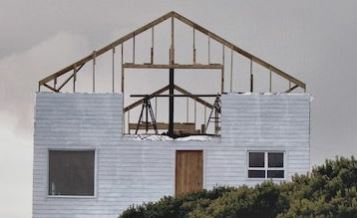Building a new home that looks and feels just right – or making big changes to the place you live – is a goal for many. But it can be a more complicated process and a very different experience to buying an existing property. And it can require a specific type of financing – a construction loan.
Maybe you already know how a standard mortgage works. Broadly speaking, you take out a loan to pay for an existing property, give that money to the owner of the property in one lump sum, then pay back what you’ve borrowed overtime – plus interest to the lender.
But when you need money to build, buy a house-and-land-package or make significant renovations or structural changes to your current home, that all changes – especially in regards to the approval process and the structure of the loan itself.
Instead of borrowing a lump sum, you take out a loan with what’s known as ‘progressive draw-down’ or ‘progress payments’ – meaning your lender will give you the money to start the process, then pay for each stage of the build or renovation when it’s time for that stage to start. Read on to learn more about the stages set out by many construction loans.
With many construction loans, you’ll just be paying interest on the amount you’ve received so far for the first 12 months. After that, the loan structure will switch to you paying both principal and any further interest accrued.
Setting yourself up for success
Applying for a construction loan can be a more complex process than applying for a mortgage. The first thing many lenders will need to do is make what’s called an ‘as if complete’ valuation of your property – put simply, this is an estimate of the market value of the land AND your new or renovated home after the work is carried out.
“Instead of borrowing a lump sum, you take out a loan with what’s known as ‘progressive draw-down’ or ‘progress payments’ – meaning your lender will give you the money to start the process, then pay for each stage of the build or renovation.”
That’s why it can also pay to have a licensed builder on board before you apply, unless you’re taking the big step of doing the work yourself, for example as an owner-builder. If you have a builder, your lender will need to see a copy of their licence and insurance policy as well as a copy of your building contract, which is often also structured in staged payments. And your lender will often need to inspect and revalue the project at each stage, especially if you’re the one swinging the hammer.
One thing to be mindful of is keeping tabs on your costs, and trying to keep your build within budget. Having a fixed cost contract doesn’t mean there aren’t other expenses that can arise – it could be as simple as changing the kitchen bench top from laminate to marble. If costs blow out further than what your lender has approved for each stage, you may need to cover that extra spending before they release the next part of the loan.
P.A.Y.G: Get paid as you go
Depending on the process set out by your chosen lender, there are usually five or six stages of draw-down progress payments you’ll receive during the build:
Deposit
With some lenders, you’re required to pay the deposit to the builder to begin construction. Others will give you this first payment to pass on.
Base
During this stage, your land is prepared for the build. Foundations or slabs are laid, and some initial plumbing work is done.
Frame
This is when the skeleton of your new place is built. Basic brickwork is laid, roofing may be installed, and some windows may be fitted.
Lockup
The installation of external doors and any remaining windows, brickwork and roofing gets finished. Put simply, your house can be locked uptight.
Fixing
Walls and roofs are plastered. Gutters, down pipes, cupboards and appliances are installed and plumbing and electrical is finished.
Completion
Almost there! Now’s the time for a few finishing touches, like painting, fencing, cleaning up the site and making any final payments to the builder.
Do I need a construction loan?
Put simply, no. But most people will. In some circumstances, you may be able to redraw equity in your block of land or an existing home loan – either for your current home or an investment property – to pay for the works required. This can be a good option for owner-builders, or those keen to do some of the work themselves.
It means you can pay construction costs at any point of the building process, rather than being bound to the stages set out by a construction loan. Just keep in mind you’ll be paying interest on the entire amount as soon as you get approved.
Some lenders offer dedicated owner-builder mortgages, too. But these require going through a more difficult application process – with the property held as security. And if you’re an owner-builder, they may consider you a high-risk client.
Ready to get started? To begin your application for a construction loan, speak to Conquer Finance today.



